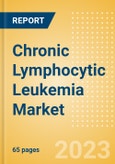Summary
This report covers the 7MM (US, France, Germany, Italy, Spain, UK, and Japan) and includes an assessment of the disease epidemiology and 10-year patient-based forecast (PBF) across the 8MM for marketed and late-stage pipeline therapies, with a launch date assessment by market for Chronic Lymphocytic Leukemia (CLL).These sales forecasts leverage data on pharmaceutical sales and drug availability from the author’s World Markets Healthcare (WMH) and POLI Price Intelligence databases.
This report includes an assessment of the disease epidemiology and 10-year patient-based forecast (PBF) across the 7MM for marketed and late-stage pipeline therapies, with a launch date assessment by market for Chronic Lymphocytic Leukemia (CLL). These sales forecasts leverage data on pharmaceutical sales and drug availability from the author’s World Markets Healthcare (WMH) and POLI Price Intelligence databases.
CLL develops from the gradual clonal development and buildup of malignant B cells in the bone marrow. They then spread to the blood and secondary lymphoid tissues such as the lymph nodes and spleen. CBy the end of the forecast period, the publisher forecasts CLL sales to reach $9.2 billion for the 7MM at a low compound annual growth rate (CAGR) of .9%. Slow growth is expected in the chronic lymphocytic leukemia (CLL) market from 2022 to 2032. Targeted drug combinations are the future of CLL treatment and chimeric antigen receptor (CAR)-T cell therapy is being evaluated in the CLL treatment landscape.
Major drivers of growth in the CLL market across the 7MM over the forecast period include the following:
- Approval of three new late-stage pipeline agents
- The sales of high-priced Breyanzi represents the most impactful driver of growth for the CLL market. Breyanzi is anticipated to launch in the 7MM during the forecast period
- The anticipated launch of Brukinsa in Japan and a continued uptake of the drug in the US and 5EU will drive sales
Major barriers to growth in the CLL market across the 7MM over the forecast period include the following:
- Patent expiries with subsequent generic competition for key BTK inhibitors as well as Venclexta
- Well-served market with few innovative approaches
- Extremely high price of next-generation BTK inhibitors could hinder their uptake in cost conscious markets
Key Highlights
- Report deliverables include a Pdf and Excel-based forecast model
- Forecasts includes the 7MM
- Forecasts covers from 2022-2032
- Slow growth is expected in the chronic lymphocytic leukemia (CLL) market from 2022 to 2032. The publisher valued the Chronic Lymphocytic Leukemia market in the 7MM at $8.4 billion and expects the market to increase to $9.2 billion by 2032
- AstraZeneca, Bristol Myers Squibb, and Loxo Oncology are expected to take market-leading position in 2032
- Unmet needs exist in CLL, particularly for patients who relapse on BTK and BCL-2 inhibitors
- Targeted drug combinations are the future of CLL treatment
Scope
- Overview of Chronic Lymphocytic Leukemia, including epidemiology, symptoms, diagnosis, and disease management.
- Annualized Chronic Lymphocytic Leukemia therapeutics market revenue, cost of therapy per patient, and treatment usage patterns forecast from 2022 to 2032.
- Key topics covered include strategic competitor assessment, market characterization, unmet needs, clinical trial mapping, and implications of these factors for the Chronic Lymphocytic Leukemia therapeutics market.
- Pipeline analysis: comprehensive data assessing emerging trends and mechanisms of action under development for Chronic Lymphocytic Leukemia treatment. The most promising candidates in Phase III and Phase IIb development are profiled.
- Analysis of the current and future market competition in the global Chronic Lymphocytic Leukemia therapeutics market. Insightful review of the key industry drivers, restraints and challenges. Each trend is independently researched to provide qualitative analysis of its implications
Reasons to Buy
- Develop and design your in-licensing and out-licensing strategies through a review of pipeline products and technologies, and by identifying the companies with the most robust pipeline.
- Develop business strategies by understanding the trends shaping and driving the global Chronic Lymphocytic Leukemia therapeutics market.
- Drive revenues by understanding the key trends, innovative products and technologies, market segments, and companies likely to impact the global Chronic Lymphocytic Leukemia therapeutics market in the future.
- Formulate effective sales and marketing strategies by understanding the competitive landscape and by analyzing the performance of various competitors.
- Identify emerging players with potentially strong product portfolios and create effective counter-strategies to gain a competitive advantage.
- Organize your sales and marketing efforts by identifying the market categories and segments that present maximum opportunities for consolidations, investments and strategic partnerships
Table of Contents
1. Preface
3. Disease Overview
4. Epidemiology
5. Current Treatment Options
7. R&D Strategies
8. Pipeline Assessment
9. Market Outlook
10. Appendix
Companies Mentioned (Partial List)
A selection of companies mentioned in this report includes, but is not limited to:
- AbbVie,AstrzaZeneca
- Bristol-Myers Squibb
- BeiGene
- Biogen
- Celgene
- Genentech
- Janssen Pharmaceuticals
- Johnson & Johnson
- Loxo Oncology
- Merck Sharpe & Dohme
- Roche
- Secura Bio








